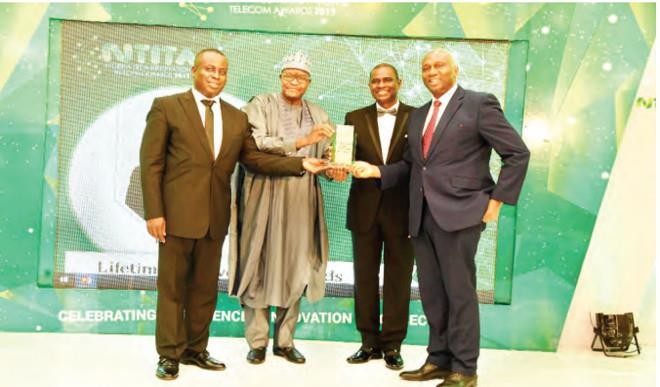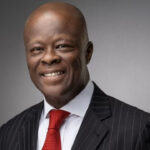
I will be addressing the following in my speech:
1. What is broadband in Nigeria
2. Industry context
3. Nigeria Broadband Initiative
4. Conclusion Seated here are industry giants in the persons of the CEOs of leading ICT companies who will À esh out my key note address during the panel discussion. What is broadband? According to the Nigerian Broadband Plan, Broadband within the Nigerian context is defined as an internet experience where the user can access the most demanding content in real time at a minimum speed of 1.5 Mbit/s. I will like to state here that different countries and jurisdictions have their own definition for broadband. However, the important thing is that broadband means connections that are ‘always on’, without the need to dial-up every time you want to go online. Broadband also means high-capacity networks that can deliver very large amounts of information simultaneously. As a result, they can deliver voice, data and video, all at the same time.” Broadband Industry Ecosystem Broadband industry ecosystem comprises of Government Policies and Programmes, Regulatory Frameworks and Environment, Supply and Demand sides of the services.
Brief Nigerian Telecommunications Industry Overview We are seeing the following trends in the industry:
1. Increasing use of data enabled devices (Smartphones, dongles, MiFis etc)
2. Voice service still more wide spread than data
3. Internet and VAS usage increasing
4. Increasing network coverage for 3G and 4G data services
5. Increased Colocation (especially for passive infrastructure)
6. Reducing Average Revenues per User
7. Increasing competition among players and Mobile broadband dominates the broadband space
8. Data infrastructure deployment and the internet market is dominated by the 4 vertically integrated GSM service providers
9. Fixed-line service substitution with mobile services due to lack of fixed infrastructure
10. The insurgency in the north-east threatens the operations and network expansion plans of service providers in the region
11. Difficulty in the deployment of needed telecommunications infrastructure
12. With pervasive voice services objective largely achieved, focus on growth of data services and provision of optimal QoS delivery from operators Current Status of Broadband Infrastructure in Nigeria Presently, we have the following:
1. Adequate international bandwidth from International Submarine Cable landings at our shores
2. Inadequate metro fiber infrastructure in several towns and cities
3. Distribution and last mile challenges
4. Over 50,000 km of inter -City Fiber laid already
5. Sub-optimal inter-city fibre capacity utilization due to duplications of some fibre routes
6. Internet access is mainly through wireless means Challenges of Broadband Development in Nigeria Demand Side
1. Cost of terminal devices
2. Relatively limited availability of locally relevant content
3. Cost of broadband access
4. Relatively low level of digital literacy
5. Unsatisfactory “broadband” speeds
6. Poor perception of broadband value
7. Relatively large population Segment with low purchasing power Supply Side
1. Relatively limited Infrastructure sharing
2. Power supply issues
3. High Right of Way charges
4. Duplication of backhaul intercity fibre
5. Lack of metropolitan bre infrastructure in several towns and cities
6. Multiple Taxation and regulation
7. Limited spectrum bandwidth
8. Discriminatory pricing by existing infrastructure owners
9. Security and Community issues
10. Damage and vandalisation of fibre infrastructure. Current Telecoms Landscape Teledensity was 99.93 as at September, 2017 Active Mobile subscriber base was 139,905,213 million as at September, 2017 Internet Penetration Rate was 50% (92.975,682 Million subs)as at September, 2017 Broadband Penetration Rate was 21% as at February, 2017 (OpenSignal) NCC Broadband Infrastructure Initiative The NCC will continue to drive and support high speed broadband connectivity to end user through various initiatives such as:
1. License InfraCos on a regional basis to provide metropolitan fibre and wholesale transmission services on a non-discriminatory, open access and price regulated basis
2. 2.3GHz spectrum has been licensed for wholesale wireless last mile services
3. On-going discussions with various levels of Government to facilitate speed in processing permits, harmonisation of tax regimes and ease of deployment of infrastructure, including streamlining RoW charges
4. Enhance competition in the market and improve consumer choices
5. Institute price caps for leased transmission capacity to address anticompetitive pricing
6. Auction and assign required spectrum for wireless and mobile broadband on an open and transparent basis Need for Government Intervention Why should government intervene in the broadband market?
1. We have terabyte capacity of international bandwidth at our shores from Main One, Glo One, Sat 3, ACE, WACS etc.
2. We have duplicated inter-city back haul infrastructure deployed by GSM, CDMA, NLD operators
3. However, there are limitations and access gaps in metro fibre deployments to nodes and neighbourhood, and last mile connection to homes and businesses. This requires government intervention to breach this gap. Objectives of the NCC Broadband Initiative The key objectives of this Next Generation Broadband Initiative of the Commission are:
1. To achieve high level of broadband penetration across all geo- political zones in the country
2. To ensure competitive and affordable pricing of high speed broadband internet
3. To position Nigeria as a leading infrastructure hub in Africa
4. To ensure development of smart incentives to support industry players
5. To contribute to the growth and development of a knowledge economy in Nigeria Key Considerations for Designing the Industry Structure for Nigeria
1. Presence of substantial intercity back haul infrastructure covering trunk routes in the country. Leverage inter-city layer 2 transmission services and/or dark fibre capacity.
2. Limited fi bre penetration and deployment in the metropolitan areas available at competitive prices.
3. Lack of end-to-end open access transmission services available on a widespread geographical basis.
4. Focus on bridging the infrastructure gap in the industry while ensuring minimal disruption to existing licenses and license conditions.
5. Ensure optic fibre infrastructure is available on a fair, neutral and nondiscriminatory basis to all operators at reasonable prices. Proposed Industry Model for Broadband Deployment The industry model for Nigeria is the open access model, which was adopted for the peculiar Nigerian market. Initially the Infraco would only play in layer 1B (Metro dark fibre), and layer 2 (active infrastructure layer) of the broadband ecosystem. However, the Commission in its wisdom and for the good of the market decided to allow infraco’s play in every segment of the value chain, and use regulatory tools such as accounting separation to discourage/mitigate/punish cross subsidization. Provision of Capacity for Wireless Last Mile Broadband is the centrepiece of the digital age. The following holds true: 1. Fibre based broadband deployments in conjunction with latest generation mobile telecommunications will drive the digital economy. In this regard, the Commission’s aim is to create the right regulatory environment that will enable licencees to deliver available, accessible, and affordable broadband services. 2. Spectrum is a critical mobile infrastructure. The Commission will strive to provide the required frequency spectrum capacity by: a. Facilitating the re-farming of existing spectrum held by operators to provide broadband services without impacting their QoS delivery b. The Auction of 2.5 / 2.6 GHz spectrum, 700 MHz band (once available) c. Open up and assign other spectrum bands in an open and transparent manner Conclusion 1. Optimal deployment of broadband infrastructures via the Infraco model in the face of existing broadband infrastructure challenges is critical to driving broadband availability, accessibility and affordability in Nigeria 2. The availability of broadband infrastructure will unlock new opportunities and drive a second wave of growth in the telecommunications industry and the economy after the exponential growth of voice service 3. Telecommunications contribution to the economy (9.5% to GDP) is signi¿ cant and will continue to grow 4. Broadband is a productivity enabling technology 5. The process for new spectrum auctions and assignments to drive mobile and wireless broadband is ongoing a. Digital Dividend (700MHz) – for 4G LTE coverage requirements b. 2.5 / 2.6 GHz spectrum auction for 4G LTE capacity requirements c. Facilitation of the Re-farming of existing frequencies for LTE d. Assign more high capacity spectrum bands like (e.g. 70/80 GHz spectrum bands). • This lecture was delivered at the Association of Telecommunications Companies of Nigeria (ATCON) event in Lagos at the weekend. Engr Wakil Bako, the Deputy Director Technical Standard and Network Integrity at NCC delivered the lecture on behalf of Prof Umar Garba Danbatta, the NCC’s Executive Vice Chairman.

 Join Daily Trust WhatsApp Community For Quick Access To News and Happenings Around You.
Join Daily Trust WhatsApp Community For Quick Access To News and Happenings Around You.

